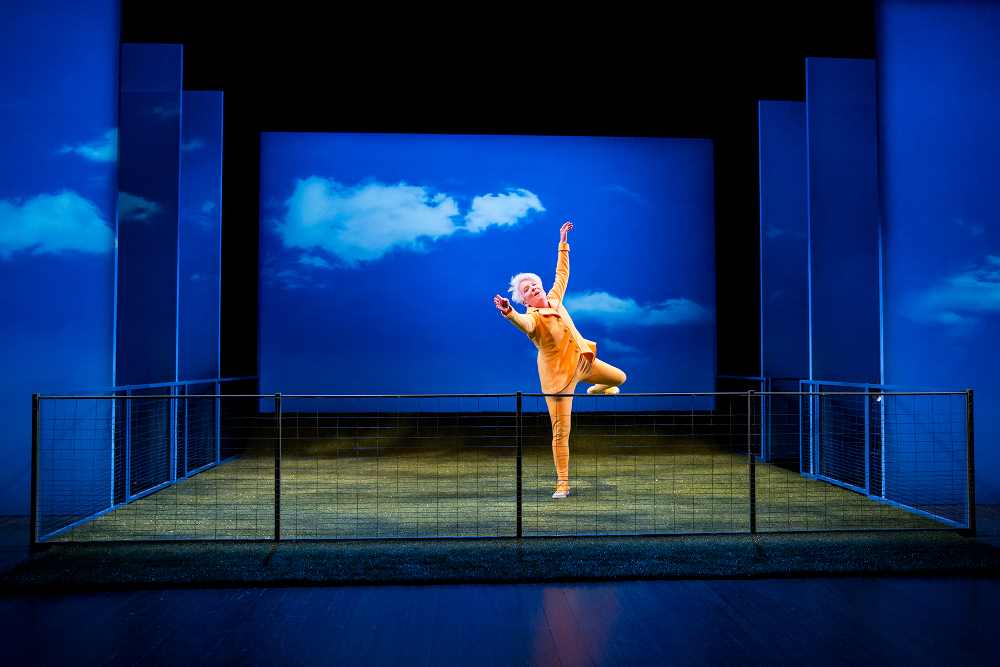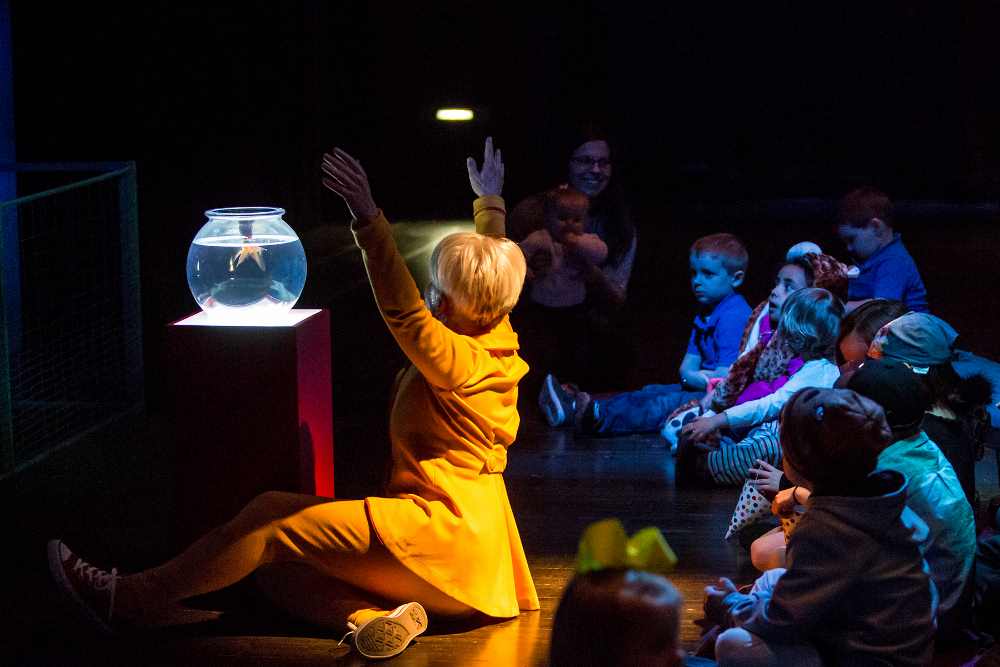The tortoise just pooped. Onstage. Laughter fills the rehearsal hall. “That was an epic sit,” says Children’s Theatre Company artistic director Peter C. Brosius, referring to the tortoise’s squatting position as it took care of business. A stagehand rushes onstage with a spray bottle and paper towels.
It’s the first day of rehearsal for Animal Dance, the newest piece by renowned choreographer and postmodern dance pioneer Ann Carlson, created with Brosius for Children’s Theatre Company in Minneapolis. Animal Dance (running March 22–May 1) promises the spectacle of Carlson dancing among a menagerie of live animals for an audience of 2- to 5-year-olds*.
At this rehearsal, to say that the live animals are behaving unpredictably would be an understatement. The animals that Carlson is working with are hardly Toto from The Wizard of Oz; they’re tame but aren’t trained to do tricks or repeat any particular movements. That’s why, though the astroturfed performance space is fully enclosed, with a picket fence in front, a white bunny named Georgine managed, within a minute of coming onstage, to squeeze through the fence and run toward the piano in the corner. It was only a few minutes later, during a dance rendition of “The Tortoise and the Hare,” that Carlson’s ambling, eightysomething-year-old tortoise, Tort, stopped before the finish line and deposited his gift.
Tortoises usually only poop once a day. But what happens if Tort chooses showtime for his bathroom break? Carlson sounds unperturbed. “Well, they’re all going to poop and we’re going to do the picking-up-the-poop dance—it’s all a part of it,” she answers jovially. “And the next time you’re picking up after your dog outside, you’ll go, ‘Oh, it’s my picking-up-the-poop dance.’”
That’s one of the underlying philosophies of Animal Dance: Anything, whether it’s walking, spinning, racing, or defecating can be a dance.
This inherent unpredictability is one of the joys of working with un-show-trained live animals. In fact, Brosius has pasted up signs all over the rehearsal room with two mottoes: “Kill all expectations” and “Everything is perfect.”
“When you have a scene partner who has no idea what they’re going to do, you can’t choreograph expectations and have them fail you,” says Brosius. “Instead, you accept their gift and receive it and dance with it.”
It’s what the team calls structured improvisation. For her part, Carlson calls it “an interspecies collaboration.”

Kill All Expectations
“Never work with children or animals,” goes a maxim often credited to actor W.C. Fields. However, Carlson actually enjoys both children (she’s a mother herself) and animals (having incorporated them into her shows since the ’80s). So when the opportunity came to combine the two, she took it as a challenge. “I think that there was a part of me that was taking on that adage, tongue-in-cheekily,” she admits.
Carlson first began dancing with live animals in the 1988 Animals, her second full-length work, which premiered at the Bessie Schonberg Theater at New York Live Arts. Whether examining the flight-or-fight mechanism with goats in “Scared Goats Faint,” or exhibiting motherly instincts in “Visit woman move story cat cat cat”—in which a nude Carlson frolicked with a kitten before picking it up with her mouth—Animals featured a series of explorations of the similarities and differences between animals and humans. She toured the work until 1996 (and graced the cover of the July/August ’92 edition of American Theatre with a kitten in her hand).
“Part of my approach and curiosity had to do with: Could the stage space be a place where these animals could be welcomed and could they be themselves?” she says. “Not trained to do tricks but just be held in the attention of the viewer with certain parameters? I was working with, in my mind, what their natural tendencies were.”
Carlson has also worked with horses, dogs, cows, and fish. Even when she wasn’t working with animals, there was an inherent down-to-earth quality in her dances, which were sometimes site-specific, as in Night Light, which took place in the streets of New York City’s Chelsea neighborhood. Other times the natural world was brought onstage, as in Rodeo, which featured Carlson dancing in a container filled with dirt.
In 2010 Carlson was invited, along with a number of nationally recognized artists such as Will Power and Eric Ting, to come to CTC and craft work for infants and toddlers. Brosius suggested Carlson do an adaptation of Animals; he says he’d seen her perform “Visit woman move story cat cat cat” at a TCG gathering in Milwaukee in the ’90s.
“When you see something that haunts you, that you don’t forget, you feel blessed, and it’s a gift to see work that’s so startling, so original,” says Brosius. “And for me, watching that dance piece of hers with that cat in Milwaukee was hugely emotional.”
CTC was one of the first American theatres to present work for toddlers—also known as Theatre for the Very Young—in 2005. Seattle Children’s Theatre and Imagination Stage in Bethesda, Md., were also early adopters. Brosius was inspired by work he’d seen abroad in Italy, Sweden, and Australia, where whole companies produce theatre exclusively for the infant and toddler set.
“We know the neural pathways for the brain are being formed between 2 and 5,” explains Brosius. It stems from another old adage: Get ’em young. “For us there’s a kind of social necessity of making sure we’re continually bringing work to the 2- to 5-year-olds, because it’s actually the most important audience you can possibly have. Because if you effect that change, you’re not only effecting an aesthetic change, you’re also affecting a physiological change, a brain chemistry change. It’s not small work, it’s big work.”

Everything Is Perfect
Creating Animal Dance wasn’t as easy as taking the original Animals and swapping full-grown goats with baby goats (though that was part of it). While Animals had five animals, Animal Dance boasts six, what Carlson calls the “Golden Book” variety: bunny, chicken, dog, goldfish, tortoise, and two goat kids.
CTC also brought in childhood development expert Patty Born Selly, author of the book Connecting Animals and Children in Early Childhood. It was her advice that helped the creators know what to expect when placing live animals and children in the same room.
“The first thing she said is: You have to remember, when the animal takes the stage, Ann stops existing,” Brosius explains. “[The children’s] eyes are going to be focused so profoundly on these animals that if she’s offstage right doing some gorgeous combination, it’s a kind of noise.”
That meant that Carlson had to interact more with the creatures of Animal Dance, and incorporate their reactions into her performance, which can be complicated when you’re dealing with untrained animals who one day may stand still for a solid minute, as with Tort, and another day may start racing across the astroturf. For Carlson, it’s a balancing act between having set choreography in the portions where she’s dancing solo, and allowing for a degree of improvisation when she’s performing a pas de deux with a chicken based on how the chicken moved during the workshop.
“In my world, improvisation and choreography are a tightly knit braid,” Carlson says. “I know in some worlds, choreography means set steps, but in this context and in many, many others, it’s a weave between responding in the moment and having fence posts of quality.”
This openness in the choreography also extended into the casting process. The animals come from a variety of places: farms, schools, and local nonprofits. For instance, Tort came from the School of Engineering and Arts, a local elementary school. The dogs came from Canine Inspired Change, a nonprofit focused on providing therapy dogs. The animals were selected based on their inherent chemistry with Carlson, as well a certain air of sociability.
“What we needed from the dogs was they could be tolerant of loud noises, that they could be tolerant and really easygoing with lots of children around, with spotlights on them, with echoes, with door slams,” says Canine Inspired Change executive director Danielle Graczyk. In short, the qualities that make for good dog performers also make for good therapy dogs. Canine Inspired Change has provided three rotating dogs for Carlson: Sharpie, a mini Australian shepherd; Izzie, a black Labrador; and Reggae, an Australian labradoodle.
Surprisingly for the creators, postmodern dance/experimental theatre and toddler theatre seem to be a good marriage. For one thing: In both forms, you can play fast and loose with the rules. “Because your audience is so young, they come into the space with absolutely no expectations for what this is supposed to be,” says CTC director of new play development Elissa Adams. “And so you have the opportunity and the responsibility to arrive at what the rules are about the interaction between the audience and the actor and the performer. They’re not necessarily coming in expecting a story with a beginning, a middle, and an end. They’re not necessarily coming in expecting naturalism or a musical theatre piece or a political play.”
“I feel like I can do anything,” enthuses Carlson. “It’s really opened up the frame more than close it down. Just thinking about abstract movement for a minute—and by that I mean movement that we might not attach function to—if I decide to wave or circle my arm 12 times kind of slowly…anything is possible.”
It’s not only the creators who can ignore the rules; that’s true of the audience as well. Shows for very young audiences at CTC take place in its Cargill Stage space, where viewers are regularly asked to take off their shoes and put on felt booties. And the seating is set up with low benches and pillows; the kids can move around during the show, switch seats, train their attention elsewhere, or participate with the actors. Any action is fair game.
“If a character onstage has lost something or is sad, a child in the audience will stand up and bring the character their sippy cup or their blanket or say they can use their shoe or any of those things,” Adams says. “There’s this kind of fluidity…The children feel this sense of being a part of the story.”
One big thing that both baby animals and human babies have in common: They’re unpredictable. During a workshop last year for Animal Dance, Carlson presented a segment in which she placed a flashlight behind a fishbowl and projected shadows of her hand onto the ceiling.
Afterward, she asked a little boy, barely a year old, sitting on his mother’s lap, what he thought. “He said, ‘The shadow.’ There were goats and turtles and chickens and dogs and fish, and he goes, ‘Shadow,’” Carlson recalls, laughing. It may have been an issue of language, Carlson muses, or it may be that when it comes to toddlers, anything and everything is interesting.
“Even though we have to attend to every second in the work, we really don’t know what is going to catch their eye. But it’s not really missing the mark. It’s opening the frame.”
*A previous version of this story erroneously reported that Animal Dance is for infants to 18-month-olds; the show is in fact made for 2- to 5-year-olds, though babies are welcomed as well.


